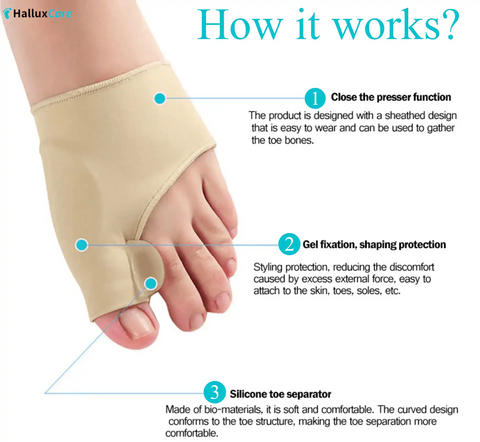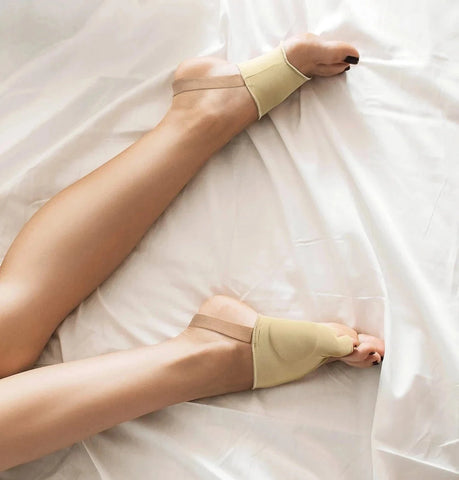Do Bunion Surgeries Really Last 20 Years? What You Should Know Before Going Under the Knife
Last Updated: Aug 2025 | Reviewed by Dr. Emily Harper, DPM (Doctor of Podiatric Medicine)
Disclaimer: This article is for informational purposes only and does not constitute medical advice. Always consult a licensed healthcare professional for diagnosis and treatment recommendations. This post contains affiliate links. We may earn a commission if you purchase through our links, at no cost to you.
Bunion pain relief and correction is a topic of growing interest, especially as more people seek long-term solutions. A recent Reddit thread raised a valid concern: “Do bunion surgeries really last 20 years, or do most people end up needing a second surgery?” This question is more than just anecdotal—it taps into the evolving science of bunion treatment, from surgical advancements to non-invasive options like the Orthopedic Bunion Pain Relief & Correction Sleeve.
4.9 ⭐⭐⭐⭐⭐ ( 1843 reviews )
Does Bunion Surgery Have an Expiration Date?
Many people assume that once a bunion is surgically removed, it’s gone for good. But this isn’t always true.
Key Facts Supported by Experts:
- According to the American College of Foot and Ankle Surgeons (ACFAS), bunion recurrence occurs in up to 25–30% of cases, depending on the surgical method used and post-op compliance.[1]
- A study published in Foot & Ankle International found that long-term recurrence is more likely when biomechanical causes of the bunion deformity aren’t corrected.[2]
Reasons for Recurrence Can Include:
- Genetics and foot structure
- Inadequate surgical technique
- Improper footwear post-surgery
- Skipping physical therapy or recovery protocols
What’s Changed in the Past 20 Years?
Surgical treatments for bunions have significantly improved over the last two decades. In the past, procedures like the traditional Chevron or Scarf osteotomy were common, but they didn’t always address the root cause of the deformity.
Modern Improvements Include:
- Minimally Invasive Bunionectomy: Smaller incisions, less tissue damage, and faster recovery times.
- Lapiplasty® 3D Bunion Correction: A newer FDA-cleared procedure that realigns the bone in all three dimensions, reducing recurrence risk.[3]
- Realistic Recovery Expectations: While some techniques advertise “same-day walking,” full recovery can still take weeks or months—something users have highlighted in forums like this Reddit thread.
Do You Really Need a Second Surgery?
Revision bunion surgery is not uncommon, especially for patients whose first procedure was more than 15–20 years ago or didn’t address structural foot issues.
According to the Cleveland Clinic,[4] reasons for revision surgery may include:
- Return of the bunion and associated pain
- Poor alignment or joint degeneration seen on X-rays
- Decreased mobility or discomfort while walking
Signs You Might Need a Second Surgery:
- Reappearance of visible bunion deformity
- Persistent foot pain or swelling
- Inability to wear shoes comfortably
- Imaging showing joint misalignment or arthritis
What Are Non-Surgical Options?
Not everyone is a candidate—or willing—to undergo surgery. Fortunately, several non-invasive tools can relieve bunion pain and help prevent progression.
Clinically Recommended Non-Surgical Options:
- Orthotics and Arch Supports: Help redistribute pressure across the foot.[5]
- Toe Spacers and Alignment Socks: Aid in gently separating the toes to reduce pressure.
- Orthopedic Bunion Sleeves: Like the one featured below, these offer realignment, pain relief, and daily support.
4.9 ⭐⭐⭐⭐⭐ ( 1843 reviews )
So, Should You Worry About Another Surgery?
If your bunion surgery was over 15 years ago and symptoms have returned, it’s a good idea to consult a podiatrist. However, don’t panic—many people find non-surgical options effective for symptom management.
Real-World Tips for Managing Recurrence:
- Wear wide, supportive footwear with a deep toe box
- Avoid high heels and narrow shoes
- Use a bunion sleeve or orthotic daily for joint support
- Schedule regular foot evaluations with a podiatrist
- Maintain a healthy weight to reduce foot pressure
Let’s Keep the Conversation Going
Have you had bunion surgery in the past? Are symptoms starting to return? What has worked for you—surgery, sleeves, shoes? Share your experience in the comments below so others can learn from your journey.
Explore HalluxCare’s Top Bunion Relief Products
If you're looking for relief from bunion pain, consider using the Orthopedic Bunion Pain Relief & Correction Sleeve, which provides targeted support and helps alleviate discomfort.
For protection from bunionette pain, the Tailor's Bunion Bunionette Pain Relief Protection Sleeves offer comfort and gentle realignment.
To soothe the skin and reduce inflammation around bunions, try the Jamaica Black Castor Oil Soothing Oil. It doubles as a nourishing oil for hair and scalp care.
Key Takeaways
- Bunion surgeries can last decades, but recurrence is not uncommon—especially with older techniques.
- Modern surgical methods like Lapiplasty have improved success and reduced recurrence rates.
- Non-surgical options such as orthopedic sleeves and proper footwear can greatly relieve pain and prevent progression.
- Consulting a podiatrist is crucial if symptoms return after surgery.
FAQs
Q: How long does bunion surgery typically last?
A: Many patients experience relief for 10–20+ years, but recurrence can happen depending on genetics, footwear habits, and surgical technique used.
Q: Is bunion surgery permanent?
A: No surgery can guarantee permanent results. However, new 3D correction methods significantly reduce recurrence risk.
Q: Can bunions return after surgery?
A: Yes. According to clinical studies, up to 30% of patients may experience some level of recurrence without proper post-op care.[1]
Q: What are good alternatives to bunion surgery?
A: Orthopedic sleeves, custom orthotics, physical therapy, and wearing supportive shoes are all viable non-surgical options.
Q: When should I consider revision bunion surgery?
A: If pain returns, your bunion visibly reforms, or you have trouble walking, consult a podiatrist for imaging and assessment.
Sources:
- American College of Foot and Ankle Surgeons. “Bunion Surgery.” ACFAS.org.
- Jastifer, J.R. et al. “Recurrence of Hallux Valgus: A Review.” Foot & Ankle International, 2014.
- Treace Medical Concepts. “Lapiplasty® 3D Bunion Correction.”
- Cleveland Clinic. “Bunion Surgery Revision.” ClevelandClinic.org.
- American Orthopaedic Foot & Ankle Society. “Non-Surgical Treatment for Bunions.” AOFAS.org.




